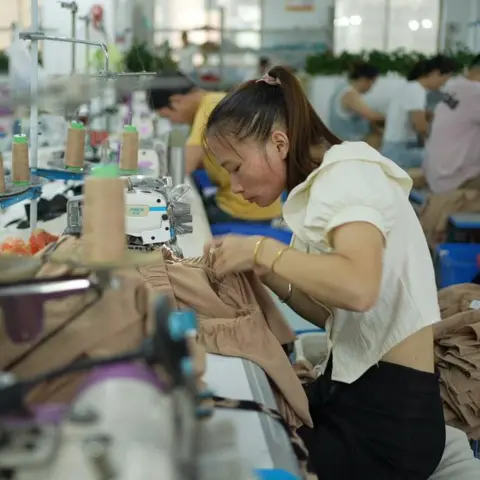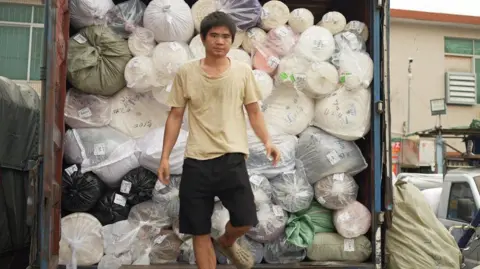 Xiqing Wang/BBC
Xiqing Wang/BBCThe hum of sewing units is a constant partially of Guangzhou, a rising port on the Pearl River in southerly China.
It rattles with the open dwelling home windows of producing amenities from early morning up till late in the course of the night time, as they find yourself the tees, shorts, shirts, trousers and swimsuit that may definitely be delivered to load closets in higher than 150 nations.
This is the noise of Panyu, the realm known as the “Shein village”, a warren of producing amenities that energy the globe’s greatest fast model service provider.
“If there are 31 days in a month, I will work 31 days,” one worker knowledgeable the BBC.
Most acknowledged they only have sometime off a month.
The BBC invested quite a few days proper right here: we noticed 10 manufacturing amenities, spoke with 4 proprietors and higher than 20 staff. We likewise hung round at work markets and cloth suppliers.
We found that the whipping coronary heart of this realm is a labor power resting behind stitching units for round 75 hours every week in battle of Chinese work laws.
These hours should not unusual in Guangzhou, a business middle for nation staff trying to find a higher earnings; or in China, which has really lengthy been the globe’s distinctive manufacturing facility.
But they contribute to a growing list of questions about Shein, as quickly as an obscure Chinese- began agency that has really ended up being a global behemoth in merely over 5 years.
Still privately-owned, it’s approximated to be value regarding ₤ 36bn ($ 60bn) and is presently taking a look at a listing on the London Stock Exchange.
Its speedy enhance, nonetheless, has really been dogged with battle regarding its remedy of staff and claims of compelled work.
Last 12 months it admitted to finding children working in its factories in China.
The agency decreased to be spoken with nonetheless knowledgeable the BBC in a declaration that “Shein is committed to ensuring the fair and dignified treatment of all workers within our supply chain” and is spending 10s of numerous bucks in enhancing administration and conformity”.
It included: “We aim to establish the greatest criteria for pay and we call for that all supply chain companions follow our standard procedure. Furthermore, Shein deals with auditors to guarantee conformity.”
Shein’s success lies in quantity – the stock on-line runs into the lots of of 1000’s – and deep reductions: £10 clothes, £6 sweaters, costs that hover beneath £8 on common.
Revenue has soared, outstripping the likes of H&M, Zara and the UK’s Primark. The cut-price gross sales are pushed by locations just like the Shein village, dwelling to some 5,000 factories, most of them Shein suppliers.
The buildings have been hollowed out to make manner for stitching machines, rolls of material and baggage brimming with material scraps. The doorways to their basements are all the time open for the seemingly limitless cycle of deliveries and collections.
As the day passes, the cabinets replenish with warehouse-bound, clear plastic baggage labelled with a now-distinctive five-letter noun.
But even previous 22:00, the stitching machines – and the folks hunched over them – don’t cease as extra cloth arrives, in vehicles so full that bolts of color generally tumble onto the manufacturing facility ground.
 Xiqing Wang/ BBC
Xiqing Wang/ BBC sc-8353772e-0 cvNhQw”>Xiqing Wang/ BBC
sc-8353772e-0 cvNhQw”>Xiqing Wang/ BBCtext-block” course =We >” says a 49-year-old lady from Jiangxi unwilling to provide her title. “On Sundays””
She is in an alleyway, the place a dozen individuals are huddled round a row of bulletin boards.
They are studying the job adverts on the board, whereas analyzing the stitching on a pair of chinos draped over it.
This is Shein’s provide chain. The factories are contracted to make garments on order – some small, some huge. If the chinos are a success, orders will ramp up and so should manufacturing. Factories then rent short-term employees to satisfy the demand their everlasting employees can’t fulfil.
The migrant employee from Jiangxi is searching for a short-term contract – and the chinos are an possibility.
“We sc-eb7bd5f6-0 fYAfXeThe gain so little. ” she says, including that she hopes to make sufficient to ship again to her two youngsters who’re residing with their grandparents.
“We earn money per item, ” she explains. “It depends just how challenging the product is.(* )basic like a tee shirt is one-two yuan Something per item and I can make around a loads in an hour.[less than a dollar] sc-eb7bd5f6-0 fYAfXe”
Examining the stitching on the chinos is essential for making that call. All round her, employees are calculating how a lot they may receives a commission to make every bit of clothes and what number of they will make in an hour.
The alleys of Panyu operate as labour markets, filling up within the mornings as employees and scooters rush previous the breakfast dumpling cart, the cups of steaming soybean milk and the hopeful farmer promoting hen and duck eggs.
 sc-8353772e-0 cvNhQw”>Xiqing Wang/ BBC
sc-8353772e-0 cvNhQw”>Xiqing Wang/ BBC< p course=” sc-eb7bd5f6-0 fYAfXe” href=” sc-eb7bd5f6-0 fYAfXe(* )_ self(* )course=” sc-c9299ecf-0 bZUiKB(* )sc-eb7bd5f6-0 fYAfXe”>a report from the Swiss advocacy group Public Eye, which was based mostly on interviews with 13 textile employees at factories producing garments for Shein.
They discovered that a variety of employees had been working extreme additional time. It famous the essential wage with out additional time was 2,400 yuan (£265; $327) – beneath the 6,512 yuan the Asia Floor Wage Alliance says is required for a ” sc-eb7bd5f6-0 fYAfXe”. But the employees we spoke to managed to earn wherever between 4,000 and 10,000 yuan a month.
“These a severe type of exploitation and this requires to be noticeable.” mentioned David Hachfield from the group. “It’s sc-eb7bd5f6-0 fYAfXe”
The common working week mustn’t exceed 44 hours, based on Chinese labour legal guidelines, which additionally state that employers ought to guarantee employees have a minimum of one relaxation day every week. If an employer desires to increase these hours, it must be for particular causes.


